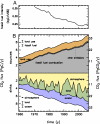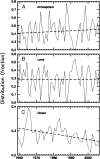Contributions to accelerating atmospheric CO2 growth from economic activity, carbon intensity, and efficiency of natural sinks
- PMID: 17962418
- PMCID: PMC2141868
- DOI: 10.1073/pnas.0702737104
Contributions to accelerating atmospheric CO2 growth from economic activity, carbon intensity, and efficiency of natural sinks
Abstract
The growth rate of atmospheric carbon dioxide (CO(2)), the largest human contributor to human-induced climate change, is increasing rapidly. Three processes contribute to this rapid increase. Two of these processes concern emissions. Recent growth of the world economy combined with an increase in its carbon intensity have led to rapid growth in fossil fuel CO(2) emissions since 2000: comparing the 1990s with 2000-2006, the emissions growth rate increased from 1.3% to 3.3% y(-1). The third process is indicated by increasing evidence (P = 0.89) for a long-term (50-year) increase in the airborne fraction (AF) of CO(2) emissions, implying a decline in the efficiency of CO(2) sinks on land and oceans in absorbing anthropogenic emissions. Since 2000, the contributions of these three factors to the increase in the atmospheric CO(2) growth rate have been approximately 65 +/- 16% from increasing global economic activity, 17 +/- 6% from the increasing carbon intensity of the global economy, and 18 +/- 15% from the increase in AF. An increasing AF is consistent with results of climate-carbon cycle models, but the magnitude of the observed signal appears larger than that estimated by models. All of these changes characterize a carbon cycle that is generating stronger-than-expected and sooner-than-expected climate forcing.
Conflict of interest statement
The authors declare no conflict of interest.
Figures


Comment in
-
Carbon cycle conundrums.Proc Natl Acad Sci U S A. 2007 Nov 20;104(47):18353-4. doi: 10.1073/pnas.0709331104. Epub 2007 Nov 12. Proc Natl Acad Sci U S A. 2007. PMID: 17998533 Free PMC article. No abstract available.
References
-
- Sabine CL, Heimann M, Artaxo P, Bakker DCE, Chen C-TA, Field CB, Gruber N, Le Quéré C, Prinn RG, Richey JE, et al. In: Global Carbon Cycle: Integrating Humans, Climate and the Natural World. Field C, Raupach MR, editors. Washington, DC: Island Press; 2004. pp. 17–44.
-
- Canadell JG, Pataki D, Gifford R, Houghton RA, Lou Y, Raupach MR, Smith P, Steffen W. In: Terrestrial Ecosystems in a Changing World. Canadell JG, Pataki D, Pitelka L, editors. Berlin: Springer; 2007. pp. 59–78.
-
- Petit JR, Jouzel J, Raynaud D, Barkov NI, Barnola JM, Basile I, Bender M, Chappellaz J, Davisk M, Delaygue G, et al. Nature. 1999;399:429–436.
Publication types
MeSH terms
Substances
LinkOut - more resources
Full Text Sources
Other Literature Sources
Molecular Biology Databases
Research Materials

